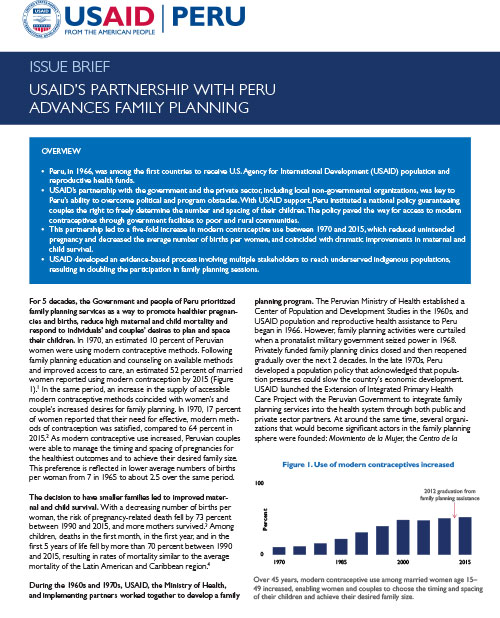Home » What We Do » Global Health » Health Areas » Family Planning » Countries » USAID's Partnership with Peru Advances Family Planning
- What We Do
- Agriculture and Food Security
- Democracy, Human Rights and Governance
- Economic Growth and Trade
- Education
- Environment and Global Climate Change
- Gender Equality and Women's Empowerment
- Global Health
- Humanitarian Assistance
- Transformation at USAID
- Water and Sanitation
- Working in Crises and Conflict
- U.S. Global Development Lab
Speeches Shim
For 5 decades, the Government and people of Peru prioritized family planning services as a way to promote healthier pregnancies and births, reduce high maternal and child mortality, and respond to individuals’ and couples’ desires to plan and space their children.
Overview
- Peru, in 1966, was among the first countries to receive U.S. Agency for International Development (USAID) population and reproductive health funds.
- USAID’s partnership with the government and the private sector, including local non-governmental organizations, was key to Peru’s ability to overcome political and program obstacles. With USAID support, Peru instituted a national policy guaranteeing couples the right to determine freely the number and spacing of their children. The policy paved the way for poor and rural communities to have access to modern contraceptives through government facilities.
- This partnership led to a five-fold increase in modern contraceptive use between 1970 and 2015, which reduced unintended pregnancies and decreased the average number of births per woman and coincided with dramatic improvements in maternal and child survival.
- USAID developed an evidence-based process involving multiple stakeholders to reach underserved indigenous populations, which resulted in doubling their participation in family planning sessions.


Comment
Make a general inquiry or suggest an improvement.